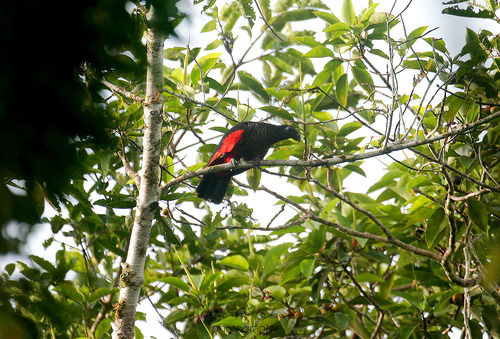
Pesquet's Parrot
The vulturine parrot, with its striking red and black plumage and bald head, thrives in New Guinea's rainforests. Known for its fig-based diet, it aids in seed dispersal, showcasing a unique ecological role. Its vulture-like appearance and exclusive feeding habits make it a captivating avian species.
Grey, Red, Black
Color
Vulnerable
Conservation Status
Decreasing
Population Trend
Characteristics
Psittrichas fulgidus, commonly known as the Pesquet's parrot or vulturine parrot, is native to the mountainous rainforests of New Guinea. This striking bird is known for its predominantly black plumage with vibrant red underbelly and wings, and a vulture-like bald head. It primarily feeds on a specialized diet of figs, playing a vital role in seed dispersal within its ecosystem.
Distribution Range of the Pesquet's Parrot
Psittrichas fulgidus, commonly known as the Pesquet's Parrot or Vulturine Parrot, is native to New Guinea. This region includes both the eastern half of the island, which is part of Papua New Guinea, and the western half, which is part of Indonesia (specifically the provinces of Papua and West Papua).
Pesquet's Parrot's Habitat
Environmental Conditions
Pesquet's Parrot is typically found in lowland and montane rainforests, usually at elevations between 600 and 1,200 meters (about 1,970 to 3,940 feet), although they can occasionally be found at higher altitudes up to 1,800 meters (5,900 feet). The climate in these regions is tropical, characterized by high humidity and frequent rainfall. The temperature is usually warm, with slight variations depending on the altitude.
Ecological Niche
This species occupies a niche as a frugivore, with a particular preference for feeding on the fruits of certain fig trees and other forest fruits. It is well-adapted to life in dense forest canopies where it forages for its food. The Pesquet's Parrot has evolved a unique feeding strategy to consume fruits that might be less accessible to other frugivorous birds, allowing it to exploit a specific ecological niche within its habitat.
Copyright @ Nature Style Limited. All Rights Reserved.
 English
English